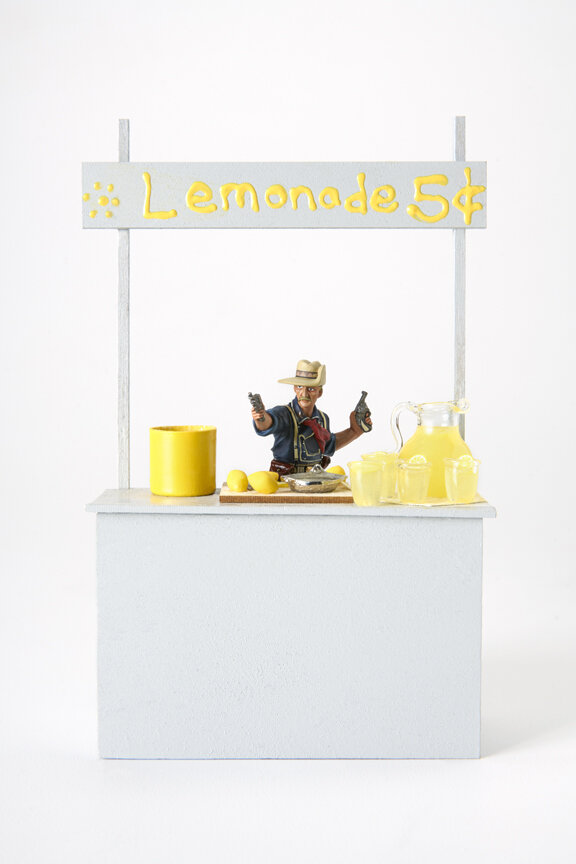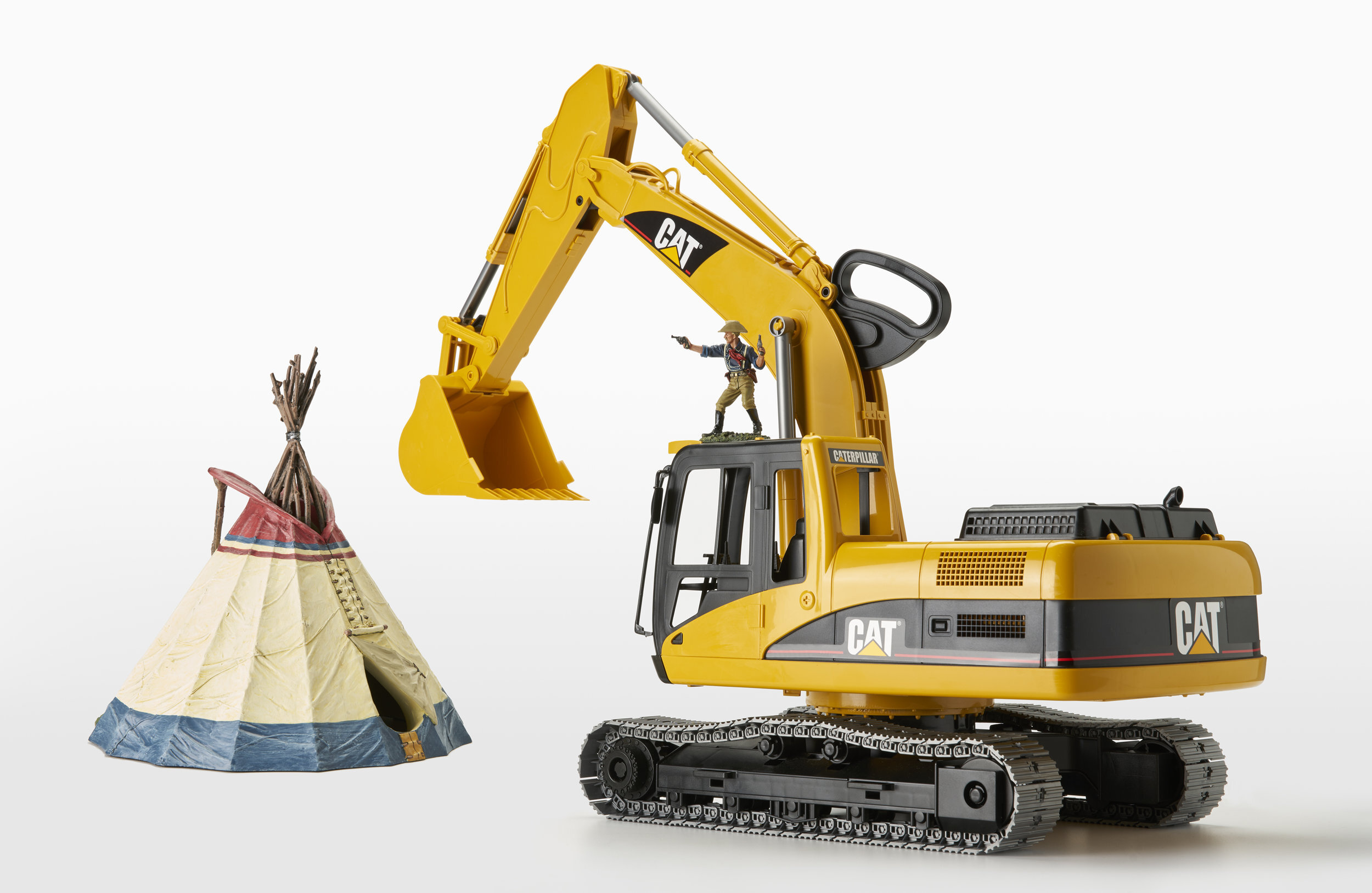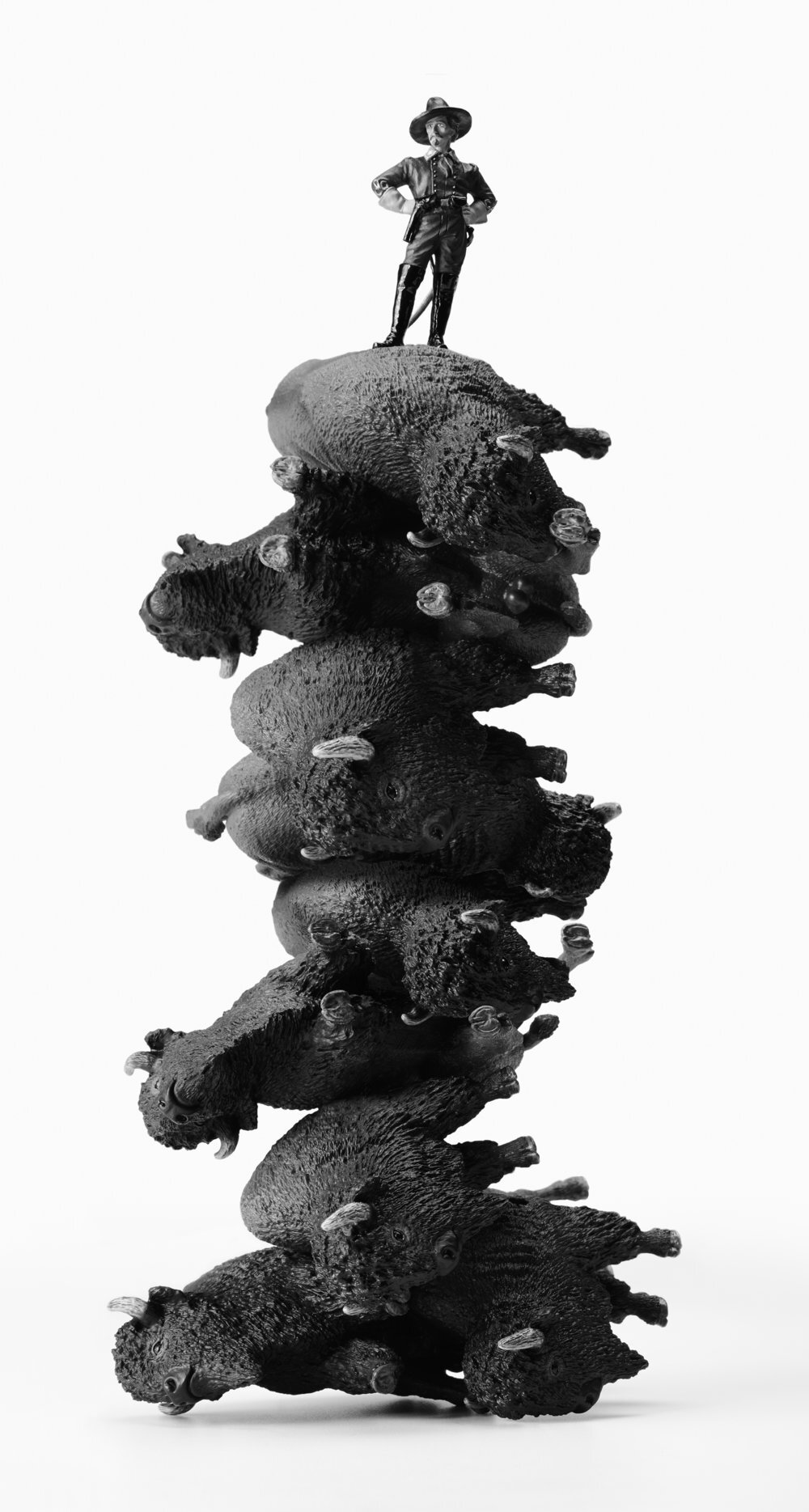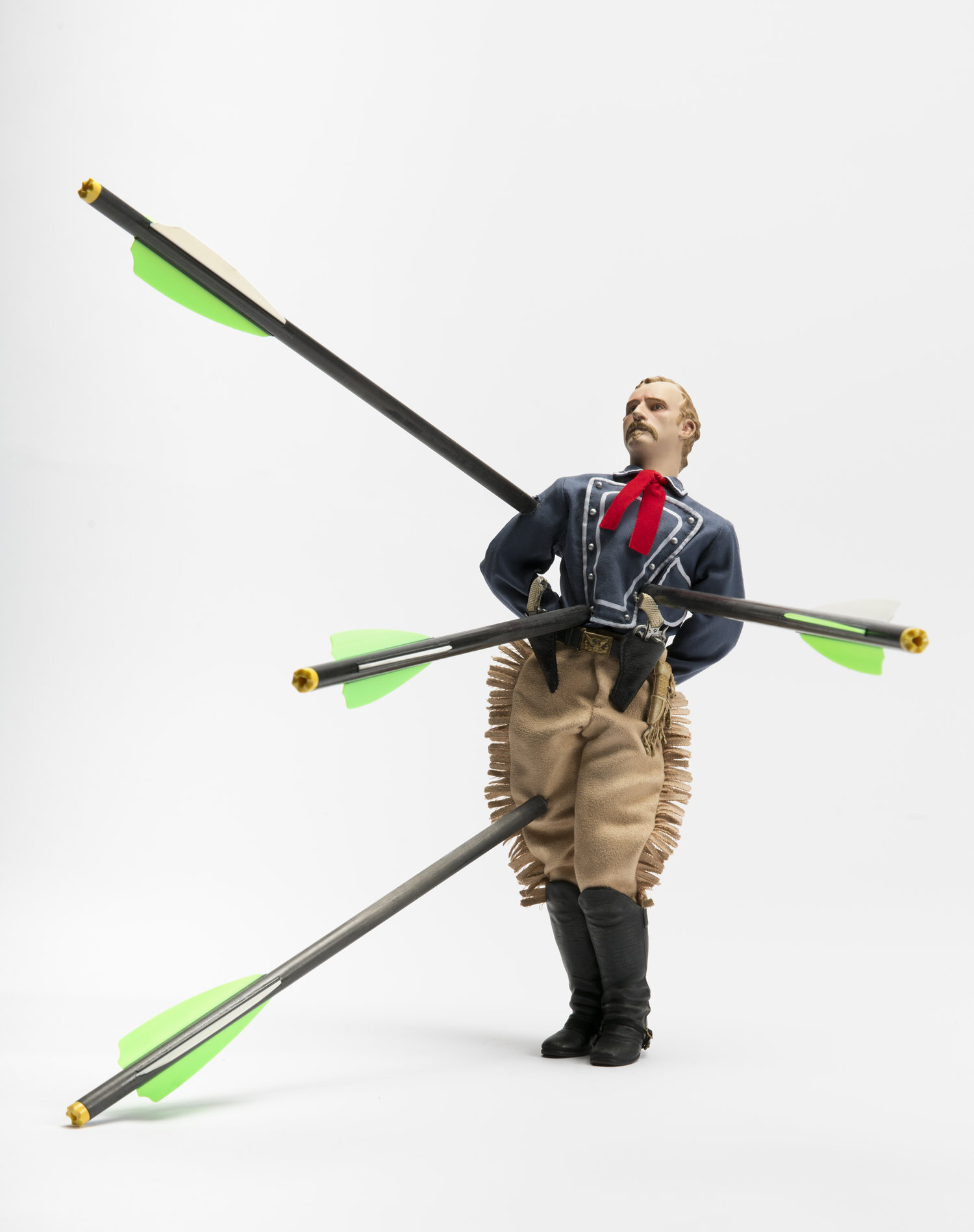CUSTER'S LAST LEMONADE STAND
Sitting Bull Dreams of Falling Soldiers
2017
Digital Print on Hahnemuhle Photo Pearl
20 x 22.5 inches
Edition of 10
Goodnight, Custer (Custer’s Death Mask)
2017
Digital Print on Hahnemuhle Photo Pearl
20 x 22.5 inches
Edition of 10
Custer’s Last Lemonade Stand
2017
Digital Print on Hahnemuhle Photo Pearl
20 x 30 inches
Edition of 10
Custer’s Last Fruit and Vegetable Stand
2017
Digital Print on Hahnemuhle Photo Pearl
20 x 30 inches
Edition of 10
Custer’s Last Lemonade Stand (Under new Management)
2017
Digital Print on Hahnemuhle Photo Pearl
20 x 30 inches
Edition of 10
#CUSTERATSTANDINGROCK
2017
Digital Print on Hahnemuhle Photo Pearl
20 x 31 inches
Edition of 10
Custer 9 - Tanaka 0
2017
Digital Print on Hahnemuhle Photo Pearl
20 x 38 inches
Edition of 10
2017
Digital Print on Hahnemuhle Photo Pearl
20 x 25.5 inches
Edition of 10
St. Custer (After Rubens)
CUSTER BRUSHED HIS TEETH AFTER EVERY MEAL
George Armstrong Custer is alive and well, 141 years after his death on June 25, 1876.
Everybody has an opinion about Custer, good, bad, good and bad, or really bad. Everybody knows about Custer and his Last Stand, his fondness for fame1, his recklessness and bravery, and all that long-hair stuff. Here is some stuff not everybody may know about Custer:
Custer is bigger than the Titanic. There are twice as many books written about him than the Titanic.
Walt Whitman liked Custer more than Timothy Egan does. Whitman wrote a poem about Custer’s death called From Far Dakota’s Canyons that contain such hooray-for-Custer lines as:
The loftiest of life upheld by death,
The ancient banner perfectly maintain'd,
O lesson opportune, O how I welcome thee!
Timothy Egan isn’t much of a Custer fan and recently wrote in the New York Times, “Custer has been shorthand for hubris, ignorance, and had it coming, but in earlier decades Custer was a hero.”
Custer had six nicknames. His first nickname was Autie because, as a child, he couldn’t pronounce his middle name, Armstrong, and the best his infant tongue could make of it was Audie. Yes, this problem with pronunciation could be considered his first blunder, but that seems a bit mean-spirited. His other nicknames were Fanny, Boy General, Iron Butt, Hard Ass and Ringlets. Custer did not like being called Ringlets.
Custer graduated dead last in his West Point class. While there, he amassed 726 demerits for such things as, “trifling in ranks marching from parade, hair out of uniform at guard meeting, throwing snowballs on barrack steps, making noise at the sink.” This snowball-throwing sink noisemaker went on, at 23, to become the youngest brevet general in the history of the United States military. This earned him the Boy General moniker.
Custer was a Civil War celebrity. He fought in 13 Civil War battles and campaigns, including Antietam and Gettysburg. The grisly war needs heroes, regardless of merit, and the press and public found one in Custer; they worshipped him for his derring-do, hairdo, and stylized uniforms.2 During the war, Custer was featured on the cover of the prestigious Harper’s Weekly three times. Custer liked publicity.
Custer had good furniture. Custer was on hand to witness Confederate General Robert E. Lee’s surrender to Union General Ulysses S. Grant on April 9, 1865 at the Appomattox home of Wilber McLean. General Phillip Sheridan, a longtime Custer sugar daddy, gifted the table on which Lee signed the surrender to Custer’s wife Libbie with the note, “Permit me to say, Madam, that there is scarcely an individual in our service who has contributed more to bring about this desirable result than your gallant husband.” Upon her death in 1933, Libbie willed the table to the Smithsonian, where it is housed to this day.
Custer repeated himself. He was court-martialed twice. On June 29, 1861, soon after graduation, Custer was acting as Officer of the Day overseeing new cadets. Two cadets got into a fight. Custer was supposed to break up the fight, but instead encouraged it. Custer was arrested. The following day Custer was asked why he didn’t break up the fight; he said, “The instincts of a boy prevailed over the obligations of an officer of the guard.” He was found guilty but only received a reprimand. In 1867, Custer was again court-martialed on eight counts that included having deserters shot and leaving his command to see his wife. He was suspended from rank and command for a year. But his boss in the west, Sheridan, let him off after 10 months to “kill Indians” because, in Sheridan’s words, “The only good Indian is a dead Indian.”
Custer had a thing for horses; however, horses may not have had a thing for Custer. He rode his horses long and hard, often through the night, and received the Iron Butt sobriquet for it. During the Civil War, Custer had 11 horses killed from under him during one of his heavily publicized charges. Sixteen days after Lee’s surrender, Custer stole a prized horse named Don Juan and rode it the Washington DC victory parade on May 23.3 Custer legally owned a number of thoroughbreds and took his two favorites Vic (for Victory) and Dandy along with him for his final campaign. Vic died with Custer on June 25, 1876, his final duty as breastwork.
Here are three facts in one about Custer’s hair: Custer scented his hair with cinnamon oil; Custer’s hair earned him his Ringlets nickname; Custer cut his golden locks short upon leaving Fort Lincoln on May 17, 1876 to meet his fate. In her memoirs, Libbie claimed the haircut was meant to soothe her because she had a dream where she saw an Indian standing over her husband’s corpse with a fresh scalp of blond curls in his hand. People less fond of Custer than his devoted wife said the reason was because he was going bald and tried to hide it with a new hairdo.4
Ronald Reagan played Custer in Santa Fe Trail. Ronald Reagan didn’t make for a very accurate Custer.
Lots of stuff is named after Custer—counties in six states, two townships, towns in 12 states, one unincorporated town, one national cemetery, one fort, one hill, one infantry division, one state park, one observatory, one airport, one mountain, one peak, nine schools, one national forest, and a golf course.5
Custer was big on personal hygiene. Libbie chided him for his fastidiousness, writing, “He brushes his teeth after every meal. I always laugh at him for it, also for washing his hands so frequently.”
Custer fought exactly two battles in the Indian Wars, winning one and losing one. He won the Battle of Washita Creek on November 27, 1868. Attacking a sleeping Cheyenne village at dawn, his troops, by most accounts other than his own, killed more old men, women and children than warriors. Custer also had 675 of the village’s horses shot. Needless to say, things didn’t go quite so swimmingly for Custer in his second battle.6
Custer was a dog guy.7 He always had dogs with him—on hunts, in battle, at the dinner table, in his tent, at his feet or on his lap, and in his bed.8 He once wrote a lousy poem9 about one of his dogs that died during a hunting expedition.
The first to welcome, foremost to defend;
Whose honest heart is still your master's own,
Who labors, fights, lives, breathes for him alone.
But who with me shall hold thy former place,
Thine image what new friendship can efface.
Best of thy kind adieu!
The frantic deed which laid thee low
This heart shall ever rue.
Four dogs accompanied Custer on his way to the Little Big Horn—Tuck, Swift, Lady, and Kaiser. Only Tuck followed alongside Custer and Vic into battle on June 25, 1876, the others stayed back at camp with their caregiver. Tuck, like Custer and Vic, did not survive.
Custer was a legendary power napper. He could hit the ground sleeping. One soldier remarked, Custer “had a habit of throwing himself prone on the grass for a few minutes’ rest and resembled a human island, entirely surrounded by crowding, panting dogs.”
Custer wore size 9C boots. This is a boring fact.
Custer had his own theme song. It was and Irish quick step called Garryowen. Garryowen started out as a drinking song in the late 18th century. Before it was Custer’s theme song, it was The Royal Irish Fusiliers’ theme song during the Napoleonic Wars; it was The Irish Regiment of Canada’s theme song during the Crimean War; and the 69th Infantry Regiment, New York Militia’s theme song. In 1940, it became the theme song of the 1940 World War I movie, The Fighting 69th, starring James Cagney, Pat O’Brian, and Alan Hale, Sr.10
Custer last known words were, “Hurrah, boys, we’ve got them!” The “boys” didn’t get them.
Custer wasn’t the only Custer who died at the Little Big Horn. Custer’s two younger brothers Thomas and Boston, his 18-year old nephew Henry Reed, and his brother-in-law James Calhoun all died June 25, 1876. Thomas Custer is the only United States soldier to receive the Medal of Honor twice. After his final battle, Thomas’ body was so badly mutilated he could only be identified by a tattoo of his initials on his arm.
Custer’s ears and penis didn’t fare too well. The dead Custer’s ears were filled with arrows because he “wouldn’t listen” and another arrow was jammed up his penis.11
Fox News got mad at President Obama about Custer. Obama gave props to Sitting Bull in his 2010 children’s book Of Thee, I Sing: A Letter to My Daughters, describing the man whose forces vanquished Custer as a “Sioux medicine man who healed broken hearts and promises… Though he was put in prison, his spirit soared free on the plains, and his wisdom touched the generations.” Fox News welcomed the book with the headline, “Obama Praises Indian Chief Who Killed U.S. General.”12
In 2010, Custer’s last flag, the 7th Cavalry guidon, sold for $2.2 million.
Custer wrote, “In years long remembered with the past, when I was merging upon manhood, my every thought was ambitious—not to be wealthy, not to be learned, but to be great.”
Not everyone was fond of Custer’s flamboyant Civil War uniforms that featured a black velveteen jacket with heavy amounts of gold embroidery, the large blue collar of a sailor’s suit, a bright red necktie or scarf, and a big floppy hat. One soldier said Custer was “…one of the funniest-looking beings you ever saw.”
The horse bolted during the parade. Also, the horse’s owner, Richard Gaines, wrote Grant to get the horse back. Grant told Custer to return the horse. Custer said he lost the horse. The horse unexpectedly died a year later from a burst blood vessel.
Walt Whitman was fond of Custer’s hair and waxed poetic, “Thou of sunny, flowing hair, in battle,/ I erewhile saw, with erect head, pressing ever in/ front, bearing a bright sword in thy hand.”
The Custer Hill Golf Course is permanently closed.
Duh.
Dogs with blogs like Custer. According to “a doggy blog written by a clever Chihuahua,” “General George Armstrong Custer was very famous, mostly because of the way he got killed by all those Indians at the Battle of Little Bighorn. Some people think he was a hero, and other people think he was an arrogant fool who got was coming to him. I used to mostly think he was an arrogant fool, but then I found out that he really, really, loved dogs. So that made me like him a little better.” Chihuahuas, even clever ones, are lousy writers.
Custer owned somewhere near 80 dogs during his life. Cardigan was Libbie’s favorite Custer dog. After Cardigan died, he found a new home in a Minneapolis public building, stuffed.
Custer was more than a lousy poet; he was a lousy writer. He wrote a lousy book called My Life on the Plains. His prose was long-winded, stilted, self-reverential, and boring. Randy J. Robertson disagrees, giving My Life on the Plains 5/5 stars on Goodreads, writing: “I find this book refreshing as the liberals both then and now portray the nobel [sic] ‘red man’ as the good guys and the settlers and soldiers as the bad guys. After reading other accounts of depridations [sic] on the early settlers and colonists by the various Indian tribes i [sic] find Custer [sic] well written [sic] accounts enlightening again my opinioin [sic] many liberal writers portray Custer as a complete idiot. You do not attend west point [sic] and graduate even if you are the lowest in the class and not be intelligent. Too bad Custer did not live beyond the battle of the little big horn [sic]. He might have made a good president.”
Father of Alan Hale, Jr., aka Skipper on Gilligan’s Island. Sr. also played Tex Bell in Santa Fe Trail.
Ouch.
Fox News later toned down the headline to “Obama Praises Indian Chief Who Defeated U.S. General.”









